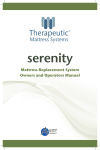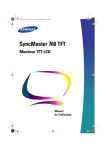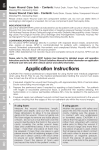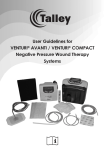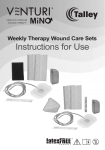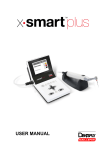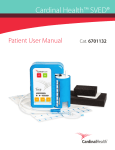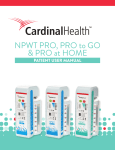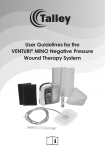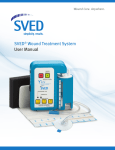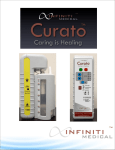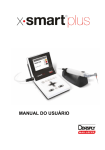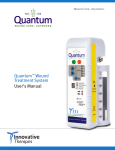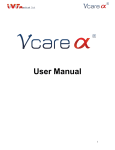Download Apex WoundPro Operating Manual - progressivemedicalconcepts.com
Transcript
Apex Negative Pressure Wound Therapy Owners and Operators Manual Negative Pressure Wound Therapy Owners and Operators Manual Table of Contents DANGER............................................................................................................... 4 WARNINGS........................................................................................................... 4 ADDITIONAL PRECAUTIONS................................................................................. 4 CAUTIONS4 INTRODUCTION................................................................................................... 5 INDICATIONS FOR USE......................................................................................... 5 CONTRAINDICATIONS FOR USE........................................................................... 5 PATIENT RISK FACTORS/CHARACTERISTICS TO CONSIDER.................................... 6 PRECAUTIONS...................................................................................................... 7 SYSTEM COMPONENTS........................................................................................ 7 Control Unit................................................................................................. 7 Canister Sets................................................................................................ 7 Power Supply.............................................................................................. 8 Dressing Kits................................................................................................ 8 Clamp.......................................................................................................... 8 SYSTEM FEATURES................................................................................................ 8 Control Unit Features................................................................................... 8 Canister Features......................................................................................... 8 SYSTEM SPECIFICATIONS..................................................................................... 9 Electrical Specifications................................................................................ 9 Equipment Symbols..................................................................................... 9 Environmental Conditions........................................................................... 9 Agency Approvals........................................................................................ 9 Electromagnetic Emissions......................................................................... 10 Electromagnetic Immunity......................................................................... 11 SAFETY INSTRUCTIONS...................................................................................... 13 INSTRUCTIONS FOR USE.................................................................................... 14 Initial Startup............................................................................................. 14 Programming Changes.............................................................................. 15 Continuous Mode Programming....................................................... 15 Intermittent Mode Programming...................................................... 15 Runtime Hours Display...................................................................... 16 Canister Changes....................................................................................... 16 Dressing Changes...................................................................................... 17 DETAILED EXPLANATION OF KEYPAD.................................................................. 19 Power Button............................................................................................. 19 Menu Button............................................................................................. 19 Up Arrow................................................................................................... 19 Down Arrow.............................................................................................. 19 Canister Light............................................................................................. 19 Alarm Mute................................................................................................ 19 Lock Out.................................................................................................... 20 ALARMS............................................................................................................. 20 Informational Alarms................................................................................. 20 Low Power........................................................................................ 20 Canister Full...................................................................................... 20 Warning Alarms......................................................................................... 20 Suction Line Blocked......................................................................... 20 Vacuum Leak..................................................................................... 21 Standby............................................................................................. 21 CLEANING AND MAINTENANCE......................................................................... 22 General Cleaning Guidelines...................................................................... 22 Cleaning Procedure................................................................................... 22 STORAGE AND CARE.......................................................................................... 22 WARRANTY......................................................................................................... 23 2 Negative Pressure Wound Therapy Owners and Operators Manual DANGER Explosion hazard - Do not use around flammable gases. Do not use in the presence of flammable gases. Never drop or insert any object into the openings on the Apex control unit. WARNINGS Failure to observe these warnings may cause serious injury or death to the patient. All instructions and guidelines in this manual and the dressing kits should be read and followed. This manual provides general guidelines for the proper use of the WoundPro® Apex NPWT System. These guidelines do not replace instructions from the patient’s physician. Failure to obtain and follow instructions from the treating physician could result in injury or death. Be aware of bone fragments, hardware or staples in the wound bed. These items could puncture the protective barrier. If the Protective barrier is punctured serious injury or death could result. Coming into direct contact with bodily fluids is potentially dangerous. Direct contact could result in serious illness up to and including death. Follow universal precautions if there is any risk of coming into contact with the contents in the Apex canister, tubing or dressing. Do not use the WoundPro® Apex NPWT System if tamper-evident seal is broken or missing. ADDITIONAL PRECAUTIONS Care should be taken when using the Apex on patients taking blood thinners or platelet aggregation inhibitors. Care should also be taken on patients with active bleeding. Care should be taken when using the Apex on patients with wound hemostasis. Care should also be taken on patients that have a history of irradiated blood vessels. Care should be taken on wounds that involve a fistula. Care should also be taken on wounds with sinus tracks and wounds with tunneling. Care should be taken when using the Apex in close proximity to blood vessels or organs. Care should be taken to avoid injury to the patient’s skin where it comes into contact with the tubing from the dressing. CAUTIONS Federal (U.S.) law restricts this device to sale by or on the order of a physician. Service work is to be done by Accuro Medical authorized personnel only. Do not immerse or spray any type of liquid directly onto the WoundPro® Apex control unit. Instead, spray a cloth and wipe down the exterior as described in the cleaning procedure (page 21). The control unit is designed to cover all internal components; however internal components are not sealed from liquid immersion, over-saturated wipes, or direct spray. Interrupting Apex therapy for more than two hours may increase the presence of bacteria in the wound bed. An increase in bacteria may raise the risk of infection. If the Apex therapy is interrupted for more than two hours remove the old dressing, irrigate the wound, and apply a new sterile dressing before resuming WoundPro® Apex therapy. www.accuromedical.com 3 Negative Pressure Wound Therapy Owners and Operators Manual Introduction Thank you for purchasing the WoundPro® Apex Negative Pressure Wound Therapy System (NPWT). The Apex offers providers various options for NPWT. We are able to do this by using the highest quality materials and advanced electronics. The custom battery system enables the Apex to operate on battery power for 24 hours. Please take the time to read the contents of this manual before using the system. If you have questions about any WoundPro® product please call 1-800-669-4757. Indications For Use The WoundPro® Apex Negative Pressure Wound Therapy System may promote wound healing, through the drainage and removal of infectious material and other fluids from the wound site using continuous and/or intermittent negative pressure. Patients with chronic, acute, traumatic, subacute and dehisced wounds, partial-thickness burns, ulcers (such as diabetic or pressure), flaps and grafts may benefit from the use of this device. The WoundPro Apex is intended for use in a healthcare facility only. Types of Wounds Indicated are: ●● Diabetic/Neuropathic ulcers ●● Pressure ulcers ●● Chronic wounds ●● Acute wounds ●● Dehisced wounds Contraindications For Use The use of the Apex NPWT system is not recommended for patients with any malignancy of the wound, untreated osteomyelitis, non-enteric or unexplored fistulas, and necrotic tissue with the presence of eschar. ●● The Apex NPWT system may be used after debridement of necrotic tissue and the complete removal of eschar. Never use the Apex NPWT system where there are exposed blood vessels, organs, or exposed bone. Do not place the Apex dressings over anastomosis, sutured vessels, or exposed nerves. ●● 4 In the cases of exposed blood vessels, organs or bone, they must first be covered with a porous, non-adherent wound contact layer prior to initiating Negative Pressure to the area. Patient Risk Factors/Characteristics to Consider Patients at high risk for bleeding and hemorrhage: Certain patients are at high risk of bleeding complications with or without the use of the Apex NPWT System. Patients that are at an increased risk of bleeding (which, if uncontrolled, could be potentially fatal) include the following: ●● Patients with weakened or friable blood vessels or organs in or around the wound as a result of, but not limited to: ❍❍ ❍❍ Suturing of the blood vessel/organ Infection – infected wounds should be monitored closely and may require more frequent dressing changes. The treating physician should determine if Apex NPWT needs to be discontinued and what treatment steps need to be taken. ❍❍ Trauma ❍❍ Radiation ●● Patients without adequate wound hemostasis ●● Patients on anticoagulants or platelet aggregation inhibitors ●● Patients without adequate tissue coverage over vascular structures. ●● Patients with Vascular Anastomosis ●● Patients with Osteomyelitis ●● Patients with exposed organs, vessels, nerves, tendons, ligaments ●● Sharp edges in the wound (i.e. bone fragments) which could puncture protective barriers, vessels or organs, which could lead to bleeding. If Apex NPWT has been prescribed for patients with an increased risk for bleeding/hemorrhage, the patient should be closely monitored by the treating physician. This device should only be used in a healthcare facility. If active bleeding develops suddenly or in large amounts during Apex NPWT, immediately stop therapy (DO NOT REMOVE THE DRESSING), take appropriate measures to stop the bleeding and seek immediate medical assistance. 800cc Canister: The 800cc canister SHOULD NOT be used on patients with a high risk of bleeding, or on patients unable to tolerate a large loss of fluid volume. When using this canister monitoring capability should be taken into account as well as patient risk factor. This canister is recommended for acute care use only. Exposed Vessels/Organs and Sharp Edges: If there are any Exposed Vessels, Organs or Sharp Edges in the wound, they must be completely covered and protected prior to the use of Apex NPWT. Sharp edges must either be removed or covered prior to treatment. MRI (Magnetic Resonance Imaging): The Apex NPWT unit is MR unsafe and should never be taken into an MRI machine. The Apex unit was not designed for this and should be considered a fire hazard. Replace the Apex Dressing with an approved dressing for use in an MRI machine. Hyperbaric Oxygen Therapy: The Apex NPWT unit has not been tested for Hyperbaric Oxygen Therapy and should be considered unsafe for use with Hyperbaric Oxygen Therapy. Never take the Apex unit into a Hyperbaric Chamber. The Apex unit was not designed for this and should be considered a fire hazard. www.accuromedical.com 5 Negative Pressure Wound Therapy Owners and Operators Manual Precautions Standard Precautions: Implement standard institutional protocol to reduce the risk of transmission of bloodborne pathogens. Continuous vs. Intermittent Apex Therapy: Research is constantly revealing the benefits of both types of therapy in different cases. The patient’s treating physician should decide which therapy mode is appropriate for the wound and the circumstances. Patient size and Weight: Patient size and weight should be considered when prescribing Apex NPWT. Fluid loss and dehydration should be closely monitored in all patients. Large wounds in relation to the patient size and weight can have excessive fluid loss and lead to dehydration. Monitor at risk patients closely. This device has not been evaluated for use in children and infants. Bradycardia: The Apex NPWT MUST NOT be placed in proximity to the Vagus Nerve. Circumferential Dressing Application: Caution should be taken when using these dressings to ensure that the circulation distal to the dressing is not impaired. System Components Control Unit The Control unit is the device that delivers the negative pressure. It is composed of a pump, lithium ion batteries, software, user interface panel and a number of sensors that monitor and adjust the vacuum pressure. Canister Sets The Apex uses either a 300cc standard canister or an 800cc large capacity canister. In most cases the 300cc canister should be used. Each canister set comes with the canister (either 300cc or 800cc), five feet of dual lumen extension tubing, a patient connector and slide clamp. The canister comes with a coagulant built inside to reduce the risk of fluid spills. The coagulant turns fluids it comes into contact with into gels. There is no discernable difference in the level of fluid in the canister with coagulant when compared to a canister without coagulant. The disposal of used canisters should be done in a manner that is consistent with state and local requirements for medical waste. If you are unsure of your local and state requirements contact the physician. CAUTION: Do not use the 800cc canister on patients that are at high risk of bleeding. Do not use it on patients that cannot tolerate large losses of fluid volume including children and elderly patients. If considering the use of the 800cc canister consider the size and weight of the patient, wound type, monitoring capability and care setting. Generally this canister should be used in acute care hospitals only. 6 Power Supply Each Apex NPWT System comes with an external switching power supply. The power supply is capable of handling: from 90 to 264Volts AC, from 0.8 to 0.4 Amps, at 47 to 63Hertz. The power supply comes with several adapters for use with many standard outlets around the world. Select the adapter that is suited for your outlet and attach it to the power supply. The other end of the cable connects directly to the Apex control unit. Dressing Kits A variety of dressing kits are available for use with the WoundPro Apex. Select the dressing kit based on the wound that is being treated. All dressing kits come with all required materials to properly apply the dressing. Clamp A clamp is provided with the Apex pump that allows you to attach the pump to an IV pole or the head / foot board of the bed. The clamp is easily attached to or removed from the back of the pump with the attached Philips screw. Simply open the clamp by turning the handle counter clockwise. Next determine which direction you want the clamp to face (side to side for pole mount, or up and down for footboard mount). Then screw the Philips screw that is on the back of the clamp into the receptacle on the back of the pump. Finally, position the clamp on the pole or footboard and turn the handle clockwise to close clamp. System Features Control Unit Features ●● Compact and lightweight power unit is quiet, robust and powerful. ●● Crisp, easy to read graphics for intuitive set up and therapy control. ●● Lock-out feature to avoid accidental therapy setting adjustments. ●● Audible and visual alarms. ●● Audible alarm mute. Canister Features ●● Two sizes (300cc and 800cc) ●● High impact plastic to reduce risk of spillage of contents. ●● Integrated filter. ●● Positive locking mechanism to help ensure canister stays firmly attached to control unit. ●● Semi-translucent to help reduce negative appearance of canister contents. ●● Coagulant in canister to help reduce the risk of spillage of contents. www.accuromedical.com 7 Negative Pressure Wound Therapy Owners and Operators Manual System Specifications Weight: Control Unit - 3.8 lbs. (1.7 Kg) Dimensions: Control Unit – 6 ¾ (W) x 8 ½ (H) x 3 ½ (D) in. (17 x 21 x 9 cm) Electrical Specifications 18VDC, 25W Switching Power Adapter Model: TR30RAM180 IEC 60601-1 EN55011 Class B Input: 90-264VAC, 0.8-0.4A, 47-63Hz Output: 18VDC 1.67A Equipment Symbols Refer to user manual SN Type CF Li-Ion Battery Do not dispose with Municipal Waste. Special Collection/Disposal Required CE Mark Environmental Conditions IP33 Operating Conditions: Ambient Temperature: +10°C to +40°C Relative Humidity: 30% to 75% Non-Condensing Storage and Shipping Conditions: Ambient Temperature: -10°C to +40°C Relative Humidity: 10% to 100% Agency Approvals UL Classified Medical Equipment UL 60601-1 CSA C22.2 No. 601.1-M90 IEC/EN 60601-1 IEC 60601-1-2 (2007) 8 Serial Number IEC 60601-1-2 Table 201 Electromagnetic Emissions The following Electromagnetic Emissions information is provided for healthcare facilities where the use of this device around other devices could result in electromagnetic interference. All WoundPro® Apex NPWT Systems are designed so that they can be used in electromagnetic environments. The use of these products in these environments should be restricted as listed in the following table. Emission Test RF Emissions CISPR 11 RF Emissions CISPR 11 Harmonic Emissions IEC 6100-3-2 Voltage Fluctuations / Flicker Emissions IEC 6000-3-3 Compliance with Standard Guidelines Group 1 (one) WoundPro® Apex products produce very little RF energy in the course of operation. The RF emissions created by the WoundPro® Apex products are very low and should not cause any interference with other electronic devices located in close proximity. Class B In terms of RF emissions all WoundPro® Apex products are safe for use in all types of buildings including private residences. In terms of RF emissions the WoundPro® Apex products are safe for use in buildings that are directly connected to low voltage public service used to supply residential buildings. Class A With respect to Harmonic emissions all WoundPro® Apex products are safe for use in all types of buildings including private residences. In terms of harmonic emissions the WoundPro® Apex products are safe for use in buildings that are directly connected to low voltage public service used to supply residential buildings. Complies With respect to voltage fluctuations and flicker emissions all WoundPro® Apex products can be used in all types of buildings including private residences. WoundPro® Apex products may be used in buildings that are directly connected to low voltage public service used to supply residential buildings. WARNING: When ever possible the WoundPro® Apex NPWT Systems should not be used when in close proximity to other electrical devices. Whenever possible do not stack the Apex pump on or under other electronic devices. If it is necessary to use the Apex in close proximity to or stacked on or under other electrical devices care must be taken to insure the Apex is performing as expected. www.accuromedical.com 9 Negative Pressure Wound Therapy Owners and Operators Manual IEC 60601-1-2 Table 202 Electromagnetic Immunity The following Electromagnetic Immunity information is provided for healthcare facilities where the use of this device around other devices could result in electromagnetic interference. All WoundPro® Apex NPWT Systems are designed for use in electromagnetic environments. The use of these products in these environments should be restricted as listed in the following table. Immunity Tests Electrostatic Discharge (ESD) IEC 61000-4-2 Electrical fast transient / burst IEC 61000-4-4 Surge IEC 61000-4-5 Voltage dips, short interruptions and voltage variations on power supply input lines IEC 61000-4-11 Power frequency (50/60 Hz) magnetic field IEC 61000-4-8 IEC 60601 Test Level Compliance Level ± 6 kV contact ± 8 kV air ± 6 kV contact ± 8 kV air ± 2 kV for power supply lines ± 2 kV for power supply lines ± 1 kV for input / output lines ± 1 kV for input / output lines ± 1 kV differential mode ± 1 kV differential mode ± 2 kV common mode ± 2 kV common mode < 5% UT (>95% dip in UT) for 0.5 cycle < 5% UT (>95% dip in UT) for 0.5 cycle 40% UT (60% dip in UT) for 5 cycles 40% UT (60% dip in UT) for 5 cycles 70% UT (30% dip in UT) for 25 cycles 70% UT (30% dip in UT) for 25 cycles < 5% UT (>95% dip in UT) for 5 seconds < 5% UT (>95% dip in UT) for 5 seconds 3 A/m 3 A/m Electromagnetic Environment Guidance Floors should be wood, concrete or ceramic tile. If floors are covered with synthetic materials (carpet) the relative humidity should be at least 30% Main power quality should be that of a typical commercial or hospital environment Main power quality should be that of a typical commercial or hospital environment Main power quality should be that of a typical commercial or hospital environment. IF the user requires continued operation during power mains interruptions, it is recommended that an uninterruptible power supply is used to power the WoundPro® Apex NPWT system. Power frequency magnetic fields should be at levels of a typical commercial or hospital environment. NOTE 1: UT is the A.C. mains voltage prior to application of the test level. 10 IEC 60601-1-2 Table 204 Electromagnetic Immunity (continued) The following Electromagnetic Immunity information is provided for healthcare facilities where the use of this device around other devices could result in electromagnetic interference. All WoundPro® Apex NPWT systems are designed for use in electromagnetic environments. The use of these products in these environments should be restricted as listed in the following table. Immunity Tests Conducted RF IEC 61000-4-6 IEC 60601 Test Level 3 Vrms 150kHz To 80 MHz Compliance Level Electromagnetic Environment Guidance Portable and mobile RF communications devices should not be used any closer to any part of the WoundPro® Apex NPWT system than the distance calculated using the following frequency formulas: 3 Vrms 80 MHz to 800 MHz = d = 1.2 √ P 800 MHz to 2.5 GHz d = 2.3 √ P Where “P” is the maximum output power rating of the transmitter in watts (W) according to the transmitter manufacturer and “d” is the recommended separation distance in meters (m) Radiated RF IEC 6100-4 3 V/m 80 MHz to 2.5 GHz 3 V/m Field strengths from fixed RF transmitters as determined by an electromagnetic site survey should be less than the compliance level in each frequency range. Interference may occur in the vicinity of equipment marked with the following symbol: NOTE 1: At 80 MHz and 800 MHz the higher frequency range applies NOTE 2: These guidelines may not apply in all situations. Electromagnetic propagation is affected by absorption and reflection from structures, objects and people. NOTE 3: Field strengths from fixed RF transmitters, such as base stations for radio (cellular / cordless) telephones and land mobile radios, amateur radio, AM and FM radio broadcast and TV broadcast cannot be predicted. To assess the electromagnetic environment due to fixed RF transmitters, an electromagnetic site survey should be considered. If the measured field strength exceeds the applicable RF compliance level above Apex operations should be closely observed to verify normal Apex operation. If abnormal operation is observed additional measures may be necessary such as relocating the Apex. NOTE 4: The frequency ranges of 150 kHz to 80 MHz the field strengths should be less than 3 V/m www.accuromedical.com 11 Negative Pressure Wound Therapy Owners and Operators Manual Safety Instructions 1.To avoid damaging the Apex control unit, be sure the power available at your location matches the power call-out on the rear of the Control Unit (i.e. 110VAC, USA; 220VAC Europe/Australia) 2.Do not spill food or liquids onto the Apex Control Unit. If a spillage does occur, disconnect it from its power supply and allow at least 24 hours for drying. 3.Do not insert items into any openings of the Apex Control Unit. Doing so may cause fire or electrical shock by shorting internal components. 4.Keep unit away from radiators or other heat sources. 5.Be sure nothing is placed on the power cable and ensure it is not located where it can be stepped on or tripped over. 6.Do not attempt to service the Control Unit except as explained in this guide. Always follow installation and servicing instructions closely. WARNING: SERVICE AND REPAIR MUST ONLY BE PERFORMED BY AN AUTHORIZED Accuro Medical Products, LLC Technician. 12 Instructions For Use CAUTION: These instructions are general guidelines. Refer to the instructions in the dressing kit for dressing changes. The physician should set the rate of dressing changes. The physician should set the expected amount of fluid that the system will remove in 24 hours. Coming into direct contact with bodily fluids is potentially dangerous. Direct contact could result in serious illness up to and including death. Follow universal precautions if there is any risk of coming into contact with the contents in the Apex canister, tubing or dressing. The following instructions are given as general guidelines and are not intended in any way to replace your organizations wound care protocol. At no time should NPWT be used without an order from a physician. All instructions provided in this manual are only suggestions and should be approved by the physician. Initial Startup: When the Apex is first powered up the entire display will illuminate. After several seconds the screen will change and you will see the software revision number. After several additional seconds the screen will change to display the last setting used. If the unit was used in intermittent mode the display will look something like this: If the unit was used in the continuous mode the display will look something like this: In either case the unit will be in standby. At this point you will want to change the setting to coincide with the physician’s orders. Follow the following programming instructions. www.accuromedical.com 13 Negative Pressure Wound Therapy Owners and Operators Manual Programming Changes: Enter the programming mode by pressing and holding the Power button and then pressing the Menu button . The mode that is currently selected (either continuous or intermittent) will be flashing on the display screen. To change between continuous and intermittent modes press either the up or down arrow keys. Continuous Mode Programming: ●● ●● ●● The current mode will be flashing. If the display shows that the unit is in “Intermittent Mode” press the up or down arrow keys to change to the “Continuous Mode” Depress the Menu button to enter the pressure adjustment mode. The pressure setting will begin to flash. Use the Up and Down Arrows to adjust the pressure. Use the up arrow to increase the pressure and the down arrow to decrease the pressure. You can set the pressures from 20 mmHg to 150 mmHg in 5 mmHg increments. When you are finished making changes press the power button programming mode and enter standby mode. to exit the Intermittent Mode Programming: ●● ●● ●● ●● ●● ●● 14 The current mode will be flashing. If the display shows that the unit is in “Continuous Mode” press the up or down arrow keys to change to the “Intermittent Mode”. Depress the Menu button to enter the time and pressure adjustment mode. The current value that you are able to change will be flashing. The top right value is the “High’ pressure setting (what the pressure will be on the high pressure). The high pressure can be set from 20 mmHg to 150 mmHg in 5 mmHg increments. The top left value is the “Low” pressure setting (what the pressure will be on the low pressure). The low pressure can be set at 0 mmHg or from 20 mmHg to 140 mmHg in 5 mmHg increments. The bottom right value is the “High Pressure” Cycle time (how long the unit will operate at the high pressure before changing to the low pressure). The high pressure time can be set from 1 minute to 10 minutes in 1 minute increments, and then up to 95 minutes in 5 minute increments. The bottom left value is the “Low Pressure” Cycle time (how long the unit will operate at the low pressure before changing to the high pressure). The low pressure time can be set from 1 minute to 10 minutes in 1 minute increments, and then up to 95 minutes in 5 minute increments. Use the Up and Down Arrows to increase or decrease the values. Note: When adjusting the pressure settings, the “High” pressure setting must always be larger than the “Low” pressure setting. Press the Menu button to cycle between the four setting (High Pressure, Low Pressure, High Pressure Cycle Time, and Low Pressure Cycle time) in the intermittent mode. When you are finished making changes press the Power button programming mode and enter standby mode. to exit the During intermittent mode operation, the corresponding cycle (low or high) flashes on the screen to indicate which therapy cycle the unit is currently providing to the patient. Runtime Hours Display: ●● ●● ●● To enter the “runtime hours” display press the menu key when the unit is in standby mode. The display show the total number of hours the Apex NPWT system has been providing therapy to the patient, both in continuous and intermittent modes. To reset the hour counter press and hold the up or the down arrow and then press the opposite arrow and release. The “runtime hours” counter will reset to zero hours. Press the Menu key to return to standby mode. Canister Changes: ●● ●● Check the volume of fluid in canister. Each canister is graduated with measurement marks on the side of the canister. Document the volume change since last dressing or canister change in patients chart. If canister is nearing the full mark replace the canister and extension tubing. To replace the canister ❍❍ Close the slide clamp on the extension tubing ❍❍ Close the pinch clamp on the drain tube ❍❍ Turn the Apex off by depressing the power button for 3 seconds ❍❍ Disconnect the extension tubing from the drain tube. ❍❍ ❍❍ ❍❍ . Remove the patient connector cap from the bottom of the canister and place it on the tip of the patient connector. Depress the blue canister release button on the top of the unit while pulling the canister away from the unit. Release the canister release button and slide the new canister into the unit. You will hear it click. CAUTION: Always monitor the amount of fluid in the canister since the last dressing change. Be sure to notate how much fluid was in the canister when it was changed. WARNING: If the amount of fluid from the wound is more than expected a serious medical condition could exist. www.accuromedical.com 15 Negative Pressure Wound Therapy Owners and Operators Manual Dressing Changes ●● ●● Determine the proper dressing based on the diameter, depth, location and caregivers preferences. Generally speaking dressings should be changed every 48 hours unless directed otherwise by physician. Verify that all kit components are accounted for and that there is no damage to the packaging of the individual items. ❍❍ ●● ●● ●● ●● There are two tubing clamps provided with the Apex system. One in the dressing kit and one in the canister kit. To disconnect the patient connector, attach the tubing clamp that comes in the dressing kit approximately 1 to 2 inches from the end of the tubing and pinch it closed. Then place the slide clamp 1 to 2 inches from the patient connector and slide it so that the clamp pinches the tubing closed. Turn Apex unit off by depressing the power button for 3 seconds . Remove old dressing from wound making sure that all components are removed. ●● Clean wound and periwound area as per organizations wound care protocol. ●● Measure wound per organizations wound measuring protocol. ●● Irrigate wound with saline, blotting away any excess saline using a sterile gauze sponge ●● Prep periwound area with skin prep, and allow prepped area to dry until sticky ●● Slide the pinch clamp onto the drain tube Applying the Wound Dressing Set ●● ●● ●● ●● ●● ●● 16 Step 1 – Debride any necrotic tissue and cleanse wound and periwound area according to institution guidelines and physician’s orders. Step 2 – Cut Non-Adherent Petroleum Gauze to the shape of the wound. Cover the entire wound bed with the Gauze. [See Figure A] Figure A Step 3 – Saturate one of the antimicrobial gauze sponges with saline, wring out excess saline, and place in the wound bed. [See Figure B] Step 4 – Trim the drain (flat or round) so the groove or holes are confined to the wound bed. Place it directly on top of the gauze applied in Step 4. Caution: Do not place the drain in a fistula tract. [See Figure C] Figure B Step 5 – Saturate additional antimicrobial gauze with saline, wring out excess saline, open and fluff into the wound to completely cover the drain and fill the wound with antimicrobial gauze to skin level. Caution: Care should be taken to ensure the gauze is restricted to the wound area and does not protrude onto the periwound area. [See Figure D] Apply skin prep and allow to dry until sticky. Figure C ●● ●● ●● Step 6 – Apply a thin strip of stoma paste (approximately 1” long X 1/8” thick) on the periwound area where the drain leaves the wound. Taper the ends of the stoma paste down to a paper thin thickness. Lay the drain tube across the strip of stoma paste. Apply a second thin strip of stoma past (approximately 1” long X 1/8” thick) over the top of the drain tube. Press drain tube into stoma paste creating a seal around the drain tube. [See Figure E] Figure D Step 7 – Cut a piece of transparent dressing 1-2 inches beyond the wound border on each side. Create an airtight seal by applying the transparent dressing starting with the side opposite the tubing. Press the dressing down firmly around the entire wound to ensure the wound environment is sealed. [See Figure F] Step 8 – Monitor the dressing to ensure that the dressing maintains a vacuum (dressing is contracted) and the volume of exudate being removed from wound is within physician’s expectation. Caution: If exudate volumes exceed physician’s expectations notify physician immediately for further instructions. Figure E Figure F Applying the Foam Wound Dressing Set ●● ●● ●● ●● ●● Step 1 – Debride any necrotic tissue and cleanse wound and periwound area according to institution guidelines and physician’s orders. Step 2 – Cut foam dressing to the shape of the wound. Care should be taken to ensure that cut pieces of foam do not fall into wound bed. [See Figure A] Figure A Step 3 – Place foam into wound bed. A proper fit will result in wound area being completely covered with no foam extending beyond the wound edges onto the periwound area. [See Figure B] Step 4 – Cut a piece of transparent dressing 1-2 inches beyond the wound border on each side. Apply skin prep to the peri wound area and allow to dry until tacky. Create an airtight seal by applying the transparent dressing over the wound and peri wound area. [See Figure C] Figure B Step 5 – Gently pull up on the transparent dressing over the center of the wound. Using scissors cut a small hole (between ½ to 1 inch round) over the center of the dressing. [See Figures D & E] Figure C www.accuromedical.com 17 Negative Pressure Wound Therapy Owners and Operators Manual ●● ●● ●● Step 6 – Remove the protective backing on the Suction Bell. Apply the suction bell over the hole cut in the transparent fill in step 4 above. Make sure that the hole is completely covered with the suction bell. [See Figure F] Step 7 – Slide the tubing clamp onto the Suction Bell tubing. Attach the Suction Bell tubing to the Patient connector. Figure D Step 8 – Monitor the dressing to ensure that the dressing maintains a vacuum (dressing is contracted) and the volume of exudate being removed from the wound is within the physician’s expectations. Caution: If exudate volumes exceed physician’s expectations notify physician immediately for further instructions. Figure E Finish (? not sure about the headings here) ●● Attach the drain tubing to the patient connector on the extension tubing, which is attached to the canister, by pushing the end of the patient connector into the drain tube. ●● Power up the pump. ●● Adjust the setting on the pump as directed by physician. ●● ●● Figure F ❍❍ Select either Continuous or Intermittent Mode. ❍❍ Set the pressures and times as directed by physician. Open both the pinch clamp and the slide clamp. Press the power button to initiate negative pressure therapy. The dressing surface should contract considerably when the pump is set to run. The system will immediately start checking for leaks. If it determines there is a leak that it cannot overcome audible and visual alarms will sound and display (see alarms section). INFORMATION: Periodically check dressing to ensure that it is place and that the air tight seal is intact. Check canister and determine volume of drainage. 18 Detailed Explanation of Keypad 3 1 5 2 4 6 1. Power 2. Menu 3. Up Arrow 4. Down Arrow 5. Canister Light 6. Alarm Mute Keypad Functions 1. Power Button 4. Down Arrow Button This key turns the Apex on and off, and also to save any programming changes and exit to standby mode. The ‘Standby’ indicator on the display is visible when the unit is on but operation of the unit has been temporarily suspended. • To activate the unit press the power button. The ‘Standby’ indicator will go away, and the unit will begin to operate. 2. Menu Button The menu button is used to select what function you want to change. It is used to select between Continuous and Intermittent modes, the pressure setting for each mode as well as the time for both high and low pressures in the intermittent mode. The menu button may also be used to enter the “Runtime hours” display when the unit is in standby mode. 3. Up Arrow Button The Down Arrow is used to decrease the setting of the currently selected function. 5. Canister Light Button This key is used to illuminate the inside the canister. This makes it easier to see the fluid level in the canister so you know when to change it. 6. Alarm Mute Button Alarm Mute is used to either temporarily or permanently mute the Apex Alarms. This is normally done to allow the provider to correct the alarm reason. • Press the ‘Alarm Mute’ button to mute for 30 minutes. Press and hold for 3 seconds to mute all alarms until the unit is powered down. You can also un-mute the alarms by pressing the “Alarm Mute” button again. The Up Arrow is used to increase the setting of the currently selected function. www.accuromedical.com 19 Negative Pressure Wound Therapy Owners and Operators Manual CAUTION: In most circumstances it is not recommended to permanently mute the Alarms. This should only be done when absolutely necessary. Lock Out A special key stroke is required to modify therapy settings. This feature is to ensure that therapy settings are not changed by accident. When the Lock Out function is engaged the “Lock” icon is displayed on the screen. This tells you that the therapy settings cannot be adjusted. Settings are “Locked” automatically when exiting the therapy adjustment menu. To “Unlock” and make adjustments to the settings press and hold the “Power” button then press the “Menu” button. Alarms The Apex NPWT system monitors several functions and will alarm if it detects a change in normal operation. There are both visual and audible alarms. Refer to the following explanation of alarm conditions to correct the issue. If the problem persists contact Accuro Medical’s customer service department. Informational Alarms Informational alarms are set off when either the battery power is low or the canister has reached its full mark. The unit will continue to operate normally for a while to allow the alarm condition to be corrected without interruption in therapy. Low Power (3 beeps every minute) This alarm sounds when the battery has less than 10% of its usable life. When the battery has less than 10% of its usable life left the battery symbol is displayed ●● To fix this alarm, plug the Apex control unit into an outlet. Canister Full (3 beeps every minute) This alarm sounds when the fluid level in the canister has reached its capacity. ●● To correct this alarm condition pause the pump and then replace the canister. Warning Alarms Warning alarms are set off when a suction line is blocked or there is a vacuum leak, or the unit is left in standby mode. These conditions affect the ability of the system to work correctly. The system will stop working until the alarm reason is corrected. Warning alarms must be addressed as quickly as possible. Suction Line Blocked (3 beeps every 5 seconds) This alarm sounds when the system’s pressure sensor detects a change in the pressure created by a blockage in the tubing or canister. ●● 20 To correct this alarm condition pause the pump and replace the canister and tubing. Vacuum Leak (3 beeps every 5 seconds) The unit continues to run for the first 30 minutes of a vacuum leak alarm. If the alarm cause is not fixed within 30 minutes, the pump will stop and the alarm will continue to sound. To correct this alarm condition, ●● Check to insure the canister is properly attached to the control unit ●● Check to insure the extension tubing is securely attached to the canister ●● Check to insure the drain tubing is securely attached to the extension tubing ●● Check to insure that the dressing is sealed around the drain tubing Standby (3 beeps every 5 seconds) This alarm activates when the unit is left in standby mode or programming mode for more than 30 minutes. The alarm is used to remind the user that the Apex unit must be returned to therapy mode after a dressing change or canister change is complete. ●● To correct this alarm condition: resume negative pressure therapy mode or power down the unit if therapy is no longer required. WARNING: Warning Alarms need to be addressed as soon as possible. The Apex stops working as long as the alarm condition is not corrected. Cleaning and Maintenance The Apex NPWT System is made to keep bodily fluids in the tubing and canister. The clamps included with the canister and dressing kit must be used to ensure bodily fluids are contained. For instructions see the sheet included with each dressing or refer to dressing instructions above. Care should always be taken to protect yourself from coming in contact with any bodily fluids. Follow your organizations protocol with respect to cleaning medical devices. WARNING: Coming into direct contact with bodily fluids is potentially dangerous. Direct contact could result in serious illness up to and including death. Follow universal precautions if there is any risk of coming into contact with the contents in the Apex canister, tubing or dressing. Wipe off dust. If necessary, clean the housing exterior with a disinfectant solution or a mild detergent and a damp cloth. Then wipe dry. DO NOT HEAT OR STEAM AUTOCLAVE THE CONTROL UNIT. www.accuromedical.com 21 Negative Pressure Wound Therapy Owners and Operators Manual General Cleaning Guidelines 1.Cleaning dirty patient care equipment should take place in a designated area. It should be done away from clean or sterile supplies and food preparation areas. 2.Detergent/disinfectants should not be mixed with other germicides or detergents. Using the proper mix insures the most effective killing power of the disinfectant. Always follow the disinfectant manufacturer’s instructions. 3.Wash hands often and well. Wash hands after removal of gloves. Pay particular attention to around and under fingernails and between fingers. Cleaning Procedure ●● ●● ●● ●● ●● ●● ●● Don protective gloves, protective apparel, and an eye protection device Remove the canister, tubing and any dressing materials still connected to the unit. Dispose of by following your “Biomedical Waste” disposal policy Prepare detergent/disinfectant (registered with the Environmental Protection Agency as a hospital disinfectant) solution according to manufacturer’s instructions. Use only hospital-grade quaternary disinfectant cleaners. Using the disinfectant solution prepared above moisten a clean cloth. Thoroughly wipe down the unit making sure to wipe all surfaces. Avoid using an oversaturated cloth and do not spray liquids directly onto the unit. Dry the unit with a clean cloth and allow to air dry for thirty minutes. Dispose of all bodily substances as directed by your organizations “Biomedical Waste” disposal policy Remove and dispose of gloves and protective apparel, and eye protective device as per facility protocol. STORAGE AND CARE Control Unit After disinfecting the unit it should be placed in a plastic bag for dust resistance. The unit should be stored in a clean area used to store electromechanical medical devices according to hospital or facility policy. 22 WARRANTY This warranty is extended only to the original purchaser. It does not affect statutory rights. Accuro Medical Products LLC, (the warrantor) warrants this product to be free from defects in materials and workmanship for a period of three (3) years covering all materials (excluding batteries) and labor costs. If within such warranty period the product shall be proven to the warrantor’s reasonable satisfaction to be defective, it shall be repaired or replaced, at warrantor’s option; warrantor’s sole obligation, and your exclusive remedy under this warranty being limited to such repair or replacement. Batteries – Rechargeable batteries are warranted for a period of six months from the date of purchase. If the product is deemed by the warrantor not to be covered under warranty a quote will be sent to you for your approval before work will begin. If you do not want the work performed a minimum charge of $45 will be charged and your product will be sent back C.O.D. using your shipper. Warranty service in the United States can be obtained during the warranty period from Accuro Medical Products LLC Please 800-669-4757 to obtain a return authorization number (RA number). No product will be accepted for return without an RA number. Shipping – The purchaser is responsible for shipping costs incurred returning broken or defective product to Accuro Medical Products LLC. Accuro Medical Products LLC will pay all shipping costs incurred in returning any parts repaired or replaced under the warranty. Limits and Exclusions There are no express warranties except as listed above. This warranty does not cover normal wear and tear. It does not cover damage which occurs in shipment. It does not cover failures which are caused by products not supplied by the warrantor. It does not cover failures which result from accident, misuse, abuse, neglect, mishandling, misapplication, alteration, faulty installation, modification, or service by anyone other than the warrantor or damage that is attributable to acts of God. www.accuromedical.com 23 Accuro Medical Products, LLC 2854 Hitchcock Avenue Downers Grove, IL 60515 Phone: 800.669.4757 www.accuromedical.com 6/12 Rev D UPC 84635400180
























